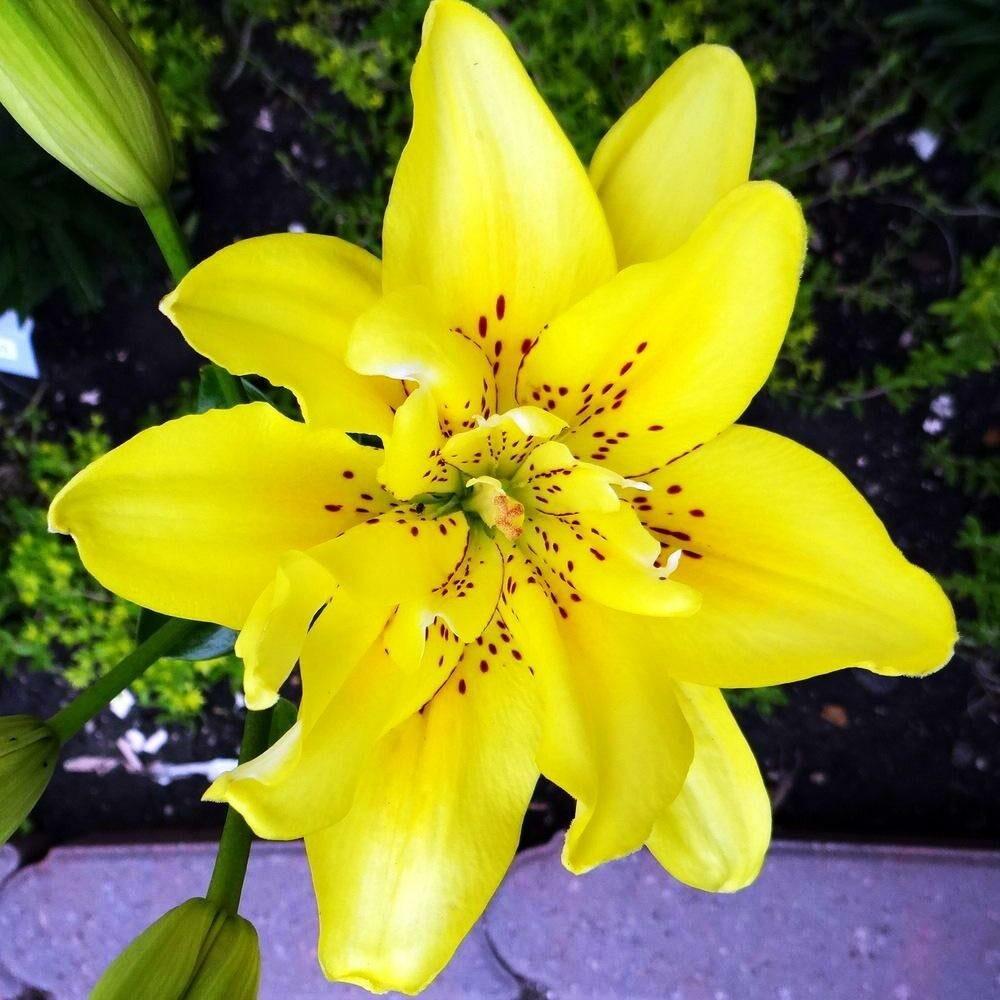Content
Lily Fata Morgana is a variety with bright yellow flowers that appear in large numbers (7-9 on one peduncle). It has a long flowering period, occurring in the second half of summer. The culture is unpretentious, so even a novice gardener can cope with cultivation. The basic rules for planting and care are described in detail in this article.
History of appearance
Little is known about the history of the selection of the Fata Morgana variety. This is a hybrid developed by crossing two varieties. That is why the plant is resistant to weather conditions, including winter frosts (up to -35 degrees in open ground).
This lily variety is not included in the register of breeding achievements in Russia. However, Fata Morgana is quite popular among many gardeners - both experienced and amateur. The flower is valued for its rich yellow color and beautiful leaves of a pleasant green hue.
Description of the Fata Morgana lily with photo
The Fata Morgana variety is an Asian double lily. It is a herbaceous perennial plant from the lily family.Asian varieties are the most unpretentious, and at the same time they have the greatest variety in color. Therefore, Fata Morgana and other representatives of the group became widespread among summer residents.
The stems of the plant are quite strong and produce numerous leaves of a narrow lanceolate shape. The color is rich herbaceous green, which creates an overall beautiful background against which the bright yellow inflorescences contrast well.
The flower stalks of the Fata Morgana lily are light green, erect, each of them produces from 7 to 9 cup-shaped large flowers. Thanks to this, the entire shoot looks like one medium-sized bouquet.

Lily Fata Morgana produces a lot of flowers on one shoot
The leaves are arranged alternately and cover the entire stem, so the bush is visually quite lush. Although the bush itself is quite compact, which many summer residents consider as an advantage, since they can save a lot of space in the flowerbed.
Features of flowering
Fata Morgana lily flowers are double. They consist of a large number of petals arranged in several rows. The color is solid yellow, quite bright. Thanks to this, all the flowers look fluffy and are clearly visible from afar. On the surface of each petal you can see reddish “freckles” - specks that attract additional attention.
The size of the flowers is quite large - in diameter after full bloom they reach 15 cm. The aroma is unobtrusive, moderate, pleasant. The flowering period occurs in the second half of summer - from July to August.
Flowers appear continuously for several weeks, most often up to 20 days. If you successfully plant varieties with different flowering periods, you can create a beautiful flower bed that will decorate your garden throughout the season.
Height of the Fata Morgana lily
The variety belongs to the group of medium-sized, reaching 90-100 cm in the summer. Lilies grow together, so there is no large difference in height. This allows you to create beautiful monoflowers and compositions with other flowers.
Advantages and disadvantages
The Fata Morgana lily variety has many advantages. On the one hand, it is truly a very beautiful flower, and on the other hand, it is a winter-hardy and unpretentious plant. Growing such a plant is quite simple.

The flowers are large, up to 15 cm in diameter
Pros:
- pleasant bright yellow inflorescences, appear in large quantities;
- long flowering period - up to three weeks;
- increased winter hardiness up to -35 degrees;
- undemanding conditions of care;
- beautiful, numerous leaves;
- compact bush.
Minuses:
- may be damaged by insects;
- every 3-4 years requires a transplant.
Planting the Fata Morgana lily
Planting lilies can be planned both in spring and early autumn. Specific deadlines depend on the region, but there are general rules. In spring, Fata Morgana lily bulbs begin to be planted in the second half of May, when the soil has warmed up well and there is no longer any threat of return frosts. The only exception is the southern regions, where work can begin at the end of April.
As for autumn planting, it is better to plan it for the end of September. But if the forecast predicts frosts (this often happens in the Urals and Siberia), it is worth starting planting 2-3 weeks earlier. In the southern regions, Fata Morgana lily bulbs are planted in the ground in early October.
There are no special soil requirements - different types of soil are suitable: sandy, sandy loam, loamy. In this case, the place should be:
- sunny (only weak partial shade is allowed);
- dry (lowlands are excluded, since water accumulates here after rains and snowmelt);
- noticeable in terms of decoration (can be planted next to the lawn, bench, entrance, on the shore of a country pond).
The process of planting Fata Morgana bulbs is not much different from other varieties of lilies. The main stages are:
- The site is first cleared, the soil is carefully dug up and planting holes 20 cm deep are formed. Since the Fata Morgana lily variety produces fairly compact bushes, the interval between holes is chosen to be about 15-20 cm. It is not worth taking a larger distance, since otherwise the flowerbed will turn out sparse and will doesn't look so nice.
- Small stones are placed at the bottom - pebbles, expanded clay (layer height 5-7 cm), then a little sand is poured.
- On the day of planting, the bulbs themselves are prepared - they are carefully inspected, all external scales are removed (if they are rotten). If there are mechanical damages, they are not paid attention to. Fata Morgana bulbs are soaked for 30 minutes in a fungicide solution, for example, Vitaros or Maxima.
- Place the bulbs bottom down. The roots are carefully straightened, and if necessary, cut off dry and damaged hairs.
- They deepen it by about 15 cm. The depth can be determined quite accurately - this is the height of the bulb itself, multiplied by 3. Most often, the figure is 4-5 cm - accordingly, the depth will be 12-15 cm.
- Sprinkle Fata Morgana lily bulbs with fertile soil. You can prepare it yourself by mixing garden soil with humus, sand and peat in a ratio of 2:1:1:1.
- Water with settled water and mulch with sawdust or bark. It is better to take a large fraction, and if it is not available, use crushed bark. The reason is that lilies do not tolerate soil compaction well.
- A week later, water with a solution of “Epin”, “Heteroauxin” or another root formation stimulator.

When planting, the bulbs are placed bottom down
The planting depth should be small - within 5-7 cm. Some of the bulbs will probably sprout, and after a year they can be transplanted to the main flower bed.
Caring for the Fata Morgana lily
The variety is unpretentious, although it requires some care. To ensure that the flowering is lush and long-lasting, and the bushes themselves do not get sick, it is recommended to follow these rules:
- Regular watering, especially often during flowering (2 times a week). The soil should always remain moist, but only moderately.
- Periodic loosening and weeding. To ensure that there are as many weeds as possible and that the soil does not dry out, it is recommended to lay a layer of mulch (peat, humus) 5 cm thick.
- Regular feeding - immediately after the snow melts, give ammonium nitrate (15-20 g per 10 l), during the formation of buds - complex fertilizer. Instead, you can pour a solution of potassium sulfate (30 g per 10 l) and superphosphate (40 g per 10 l). A similar fertilizing is applied every 2-3 weeks until mid-August.
- After 3-4 years, the Fata Morgana lily bushes must be transplanted to a new location. It is better to do this in the second half of September, a few weeks before the onset of the first frost. Otherwise, the bulb becomes loose, and the peduncles become noticeably lower.
- Every autumn (October), when the stems die, they are cut off, leaving 12-15 cm from the surface. Shelter for the winter as such is not required. But in regions with a frosty climate, it is advisable to mulch the flowerbed.

Thanks to timely watering and fertilizing, the lily will bloom for a long time.
Reproduction
Fata Morgana, like other varieties, can be propagated in several ways:
- Bulbs.
- Bulb scales.
- Bulbs.
The first option is the main one, it is implemented every 3-4 years during transplantation. The nest is divided into its component parts, each Fata Morgana lily bulb is treated in a fungicide solution, and then transplanted to a new location.
The plant can also be propagated using scales that form at the base. On each such scale, 3-4 new bulbs appear. Therefore, it is enough to separate them and plant them. The method is very effective, but it takes 2-3 years to obtain an adult bush.
There is also a way to propagate the Fata Morgana lily by bulbs. In all Asian hybrids they form in the leaf axils. Closer to the beginning of autumn, they are separated and planted in a separate place.
There is also a seed method for propagating lilies. But in practice it is used quite rarely. The reason is that seedlings are not so easy to grow. In addition, you need to purchase seeds separately, since Fata Morgana is a hybrid variety.
Conclusion
Lily Fata Morgana is one of the best in terms of unpretentiousness and decorative qualities. It can withstand even severe frosts, so it does not need shelter. Tolerates adverse weather conditions well, minimal care requirements.








